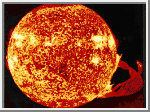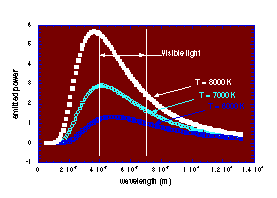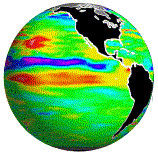 "What is Physics Good For?"
"What is Physics Good For?"
Extra credit is available at the end of this page. Please respond before 9 AM, Tuesday, September 5th, 2000.

Color and Temperature
Another thing
physics is good for is making connections between apparently unrelated subjects.
Physics is supposed to explain everything right? So everyhing is related
to everything else through physics (sounds a bit religious doesn't it?).
Here goes.
Color is related to the frequency
(or wavelength) of light. The visible spectrum runs from red, wavelength
= 700 nm and f = 4.3 x 1014 to blue, wavelength = 400 nm and
f = 7.5 x 1014.
But temperature is also related to color. This is because hot things radiate
light (for instance, the filament in an incandescent bulb). The temperature
of the object affects the color of the light that is radiated. "Red
hot" things glow red, "white hot" things glow white.
 How does this work? There are some complicated details, but here is the basis: as we discussed in class, temperature is a measure of the internal energy of a material. The hotter a material is, the faster its atoms
are moving. But light is emitted when charged
particles vibrate. If an electron or an ion (the core of an atom, including
its inner electrons but not those involved with bonding) is vibrating fast
enough, it may emit light. Clearly, the hotter an object is, the more often
this will happen, and the higher the frequencies involved will be. Thus,
a hot object that appears a dim red is cooler than one which is bright orange.
An even hotter object will be emitting radiation across the whole visible
spectrum resulting in a white appearance(for instance, the filament in an
incandescent bulb). The exact distribution of colors emitted by a material at a given temperature depends a bit on the composition of the material. However, to a great extent it does not. The "ideal" spectrum is known as "Blackbody radiation" or the "blackbody spectrum". For a given temperature blackbody, the spectrum has a peak at some particular wavelength. The hotter the body, the shorter ("bluer") the wavelength at the peak. An example is shown in the graph
How does this work? There are some complicated details, but here is the basis: as we discussed in class, temperature is a measure of the internal energy of a material. The hotter a material is, the faster its atoms
are moving. But light is emitted when charged
particles vibrate. If an electron or an ion (the core of an atom, including
its inner electrons but not those involved with bonding) is vibrating fast
enough, it may emit light. Clearly, the hotter an object is, the more often
this will happen, and the higher the frequencies involved will be. Thus,
a hot object that appears a dim red is cooler than one which is bright orange.
An even hotter object will be emitting radiation across the whole visible
spectrum resulting in a white appearance(for instance, the filament in an
incandescent bulb). The exact distribution of colors emitted by a material at a given temperature depends a bit on the composition of the material. However, to a great extent it does not. The "ideal" spectrum is known as "Blackbody radiation" or the "blackbody spectrum". For a given temperature blackbody, the spectrum has a peak at some particular wavelength. The hotter the body, the shorter ("bluer") the wavelength at the peak. An example is shown in the graph

The color/temperature relationship is extremely useful, and many different
processes and devices make use of the relationship between temperature and
color. One example is photographic film and lighting equipment. Color film
contains photosensitive chemicals that record the light which strikes them.
Different chemicals are sensitive to different colors of light. The mixture
of these chemicals on the film affects how sensitive the film is across
the visible spectrum. You want film that is "balanced", that is,
it is sensitive to different colors in the same proportions that are present.
But these proportions depend on the light source! Film balanced for sunlight
is different than film balanced for flash. Incandescent light is different
still. The manufacturers of film
(Kodak, Fuji, etc.)
specify the balance
of film by specifying the temperature of the light. For instance, sunlight
has a temperature of 5500 K.
 Scientists also use color as a visual indicator of temperature, radiation intensity, or other properties. Images that are acquired with radio telescopes, infrared detectors or other
instruments may be "color coded" so that the data may be more easily interpreted. The image to the left shows data on the "El Nino" of 1997-98. This phenomenon, a increase in the temperature of the surface waters in the eastern Pacific ocean can cause severe economic damage in the US and elsewhere due to flooding and other climatic changes.
Scientists also use color as a visual indicator of temperature, radiation intensity, or other properties. Images that are acquired with radio telescopes, infrared detectors or other
instruments may be "color coded" so that the data may be more easily interpreted. The image to the left shows data on the "El Nino" of 1997-98. This phenomenon, a increase in the temperature of the surface waters in the eastern Pacific ocean can cause severe economic damage in the US and elsewhere due to flooding and other climatic changes.
Steelmakers and others who must heat materials to specific temperature
ranges use the temperature/color relationship to visually determine when
a material is "hot enough." There is a fairly standard nomenclature:
| Temperature (°C) | Color |
|---|
| 480 | Barely red in the dark |
| 600 | Dark red |
| 800 | Cherry red |
| 950 | Orange, barely visible in sunlight |
| 1100 | Orange-yellow, visible in bright sunlight | | 1300 | Light yellow, nearly blinding, welding goggles required. |
| 1500 | Nearly white, blinding |

A last example is a category of devices known as "optical pyrometers."
These are a type of thermometer that measures the temperature of an object
by measuring the color of the light coming from it. That is, it is a device
which does quantitatively the same chore that your eye does qualitatively
in using the scheme above.
You can get a lot more information about this subject on the internet. Here are a few search engines
1. Alta Vista
2. Google
3. Northern Light
4. Ask Jeeves
5. Infoseek
And here are a few good links to get you started.
1. 2.
2. 3.
3. 4.
4.
Research Questions (1 point extra credit each!)
- What temperature is "Tungsten light" (which comes from an incandescent bulb)
- What is "Wein's displacement Law"
- Under what conditions would a pyrometer be the best choice to measure temperature?
- What does "incandescent" mean.
This site is made possible by funding from the National Science Foundation (DUE-9981111).
©2001 A. Gavrin and G. Novak, all rights reserved.
|



 "What is Physics Good For?"
"What is Physics Good For?"
 How does this work? There are some complicated details, but here is the basis: as we discussed in class, temperature is a measure of the internal energy of a material. The hotter a material is, the faster its atoms
are moving. But light is emitted when charged
particles vibrate. If an electron or an ion (the core of an atom, including
its inner electrons but not those involved with bonding) is vibrating fast
enough, it may emit light. Clearly, the hotter an object is, the more often
this will happen, and the higher the frequencies involved will be. Thus,
a hot object that appears a dim red is cooler than one which is bright orange.
An even hotter object will be emitting radiation across the whole visible
spectrum resulting in a white appearance(for instance, the filament in an
incandescent bulb). The exact distribution of colors emitted by a material at a given temperature depends a bit on the composition of the material. However, to a great extent it does not. The "ideal" spectrum is known as "Blackbody radiation" or the "blackbody spectrum". For a given temperature blackbody, the spectrum has a peak at some particular wavelength. The hotter the body, the shorter ("bluer") the wavelength at the peak. An example is shown in the graph
How does this work? There are some complicated details, but here is the basis: as we discussed in class, temperature is a measure of the internal energy of a material. The hotter a material is, the faster its atoms
are moving. But light is emitted when charged
particles vibrate. If an electron or an ion (the core of an atom, including
its inner electrons but not those involved with bonding) is vibrating fast
enough, it may emit light. Clearly, the hotter an object is, the more often
this will happen, and the higher the frequencies involved will be. Thus,
a hot object that appears a dim red is cooler than one which is bright orange.
An even hotter object will be emitting radiation across the whole visible
spectrum resulting in a white appearance(for instance, the filament in an
incandescent bulb). The exact distribution of colors emitted by a material at a given temperature depends a bit on the composition of the material. However, to a great extent it does not. The "ideal" spectrum is known as "Blackbody radiation" or the "blackbody spectrum". For a given temperature blackbody, the spectrum has a peak at some particular wavelength. The hotter the body, the shorter ("bluer") the wavelength at the peak. An example is shown in the graph

 Scientists also use color as a visual indicator of temperature, radiation intensity, or other properties. Images that are acquired with radio telescopes, infrared detectors or other
instruments may be "color coded" so that the data may be more easily interpreted. The image to the left shows data on the "El Nino" of 1997-98. This phenomenon, a increase in the temperature of the surface waters in the eastern Pacific ocean can cause severe economic damage in the US and elsewhere due to flooding and other climatic changes.
Scientists also use color as a visual indicator of temperature, radiation intensity, or other properties. Images that are acquired with radio telescopes, infrared detectors or other
instruments may be "color coded" so that the data may be more easily interpreted. The image to the left shows data on the "El Nino" of 1997-98. This phenomenon, a increase in the temperature of the surface waters in the eastern Pacific ocean can cause severe economic damage in the US and elsewhere due to flooding and other climatic changes.

